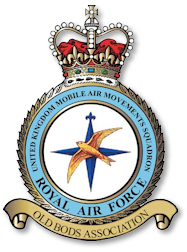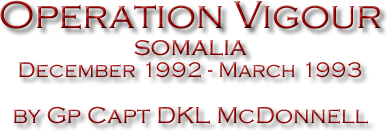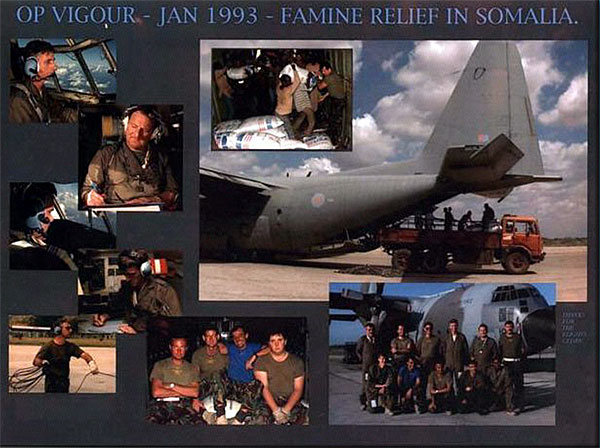



The more usual humanitarian mission is exemplified by Operation VIGOUR. Once again it was generated by the FCO following discussions with the US and a successful visit by Baroness Chalker, in one of our aircraft, to some up-country strips in Somalia to talk to local leaders. However, our contribution was to be part of the US led Operation PROVIDE RELIEF, delivering UNHCR aid to southern Somalia. This, in turn, was part of the over arching Operation RESTORE HOPE, aimed at restoring some form of stability to the region. While that operation cannot yet be called a total success - some would doubt that it ever would be - the provision of relief supplies was.
Again, much preparatory work took place in planning our contribution. We despatched a wing commander to HQ CENTCOM in Florida to liaise closely with US staff on Command and Control and basing arrangements. The sheer scale of the operation was creating basing problems. There were no secure airfields in Somalia, therefore all deployed aircraft had to operate from Kenya, either from Nairobi or Mombasa. Such was the problem that we did not know where we were to operate from until 2 days before the aircraft departed
Again, much preparatory work took place in planning our contribution. We despatched a wing commander to HQ CENTCOM in Florida to liaise closely with US staff on Command and Control and basing arrangements. The sheer scale of the operation was creating basing problems. There were no secure airfields in Somalia, therefore all deployed aircraft had to operate from Kenya, either from Nairobi or Mombasa. Such was the problem that we did not know where we were to operate from until 2 days before the aircraft departed
Two Hercules were allocated for the task and had to be prepared for strip operations by Lyneham engineering personnel, a time consuming process. Again diplomatic clearances had to be sought, not only from Kenya for basing, but also from Egypt and Sudan for over flight by detachment and re-supply aircraft. Support aircraft were tasked and personnel detailed to form the initial detachment. These included ground engineers to service the aircraft, UKMAMS to load and offload the aircraft with local labour help, RAF Police to provide aircraft and crew protection and to control weapon issue, administrative staff to sort out accommodation, hire the vehicles and control the all-important imprest, medical staff for obvious reasons, operations officers and clerks to liaise with the US Joint Task Force airlift co-ordination cell over our tasking and, most importantly, a detachment of Tactical Communications Wing personnel to provide the essential secure telephone, signals and radio links. Add the 4 crews from the 2 aircraft and the detachment amounted to 62 personnel drawn in the main from 38 Group, with 1 or 2 guest appearances.
They deployed to Mombassa on 10 December 92 in time for Christmas, joining aircraft of the USAF, German Air Force and Canadian Air Force. During the following 3 months the RAF delivered some 3,500 tons of supplies to all areas of Somalia, flying just short of 1,000 hours in the process. We also provided an Air Commander to be forward-based in Mogadishu once it had been secured, to look after our national interests with the US Joint Task Force Commander . In the event, for a variety of reasons, this was not possible. Nevertheless, the Air Commander was able to maintain that essential coordination through regular visits and secure lines of communication. He also managed to have his photograph taken with the then President Bush!
They deployed to Mombassa on 10 December 92 in time for Christmas, joining aircraft of the USAF, German Air Force and Canadian Air Force. During the following 3 months the RAF delivered some 3,500 tons of supplies to all areas of Somalia, flying just short of 1,000 hours in the process. We also provided an Air Commander to be forward-based in Mogadishu once it had been secured, to look after our national interests with the US Joint Task Force Commander . In the event, for a variety of reasons, this was not possible. Nevertheless, the Air Commander was able to maintain that essential coordination through regular visits and secure lines of communication. He also managed to have his photograph taken with the then President Bush!
Throughout the deployment, staff at High Wycombe provided the all important command function and through links with the MOD and FCO, were able to give the detachment political and operational direction. Clearly, in what was to become an ever-changing scenario, the role of intelligence was crucial. Indeed, intelligence is an essential ingredient when assessing risk - the detachment commander's major pre-occupation - and it does create a problem when it is thin on content, as a crew found out one day when tasked to a strip in Northern Somalia where they had not been before.
Information from another nation, operating in-theatre but not from Mombasa, indicated that the strip was sound and the natives friendly. The aircraft landed, to be met by a UNHCR representative and a large crowd who, to the crew, were bordering on hostile.
Nevertheless the VIP disembarked, perhaps looking a little paler than normal, to talk with the local leader and the UNHCR representative. During these discussions the crew learned that they had just landed on a strip with land mines marking the edge of the runway! The take-off and flight back were uneventful but history does not record the discussion on the flight deck.
Information from another nation, operating in-theatre but not from Mombasa, indicated that the strip was sound and the natives friendly. The aircraft landed, to be met by a UNHCR representative and a large crowd who, to the crew, were bordering on hostile.
Nevertheless the VIP disembarked, perhaps looking a little paler than normal, to talk with the local leader and the UNHCR representative. During these discussions the crew learned that they had just landed on a strip with land mines marking the edge of the runway! The take-off and flight back were uneventful but history does not record the discussion on the flight deck.


